Transcription from the talk (unedited)
Message from Shiloh Sophia, Part History, Party Mystery, and a whole lot messy - as I navigate the energies and stories of this season and invite you to do the same…
Good Morning Beloved Ones.
As we enter into this next cycle of time, which in many ancient parts of the world is honored as the time after the vernal equinox and the time after the first full moon and the time after the Passover, we enter into a cycle known as Easter or Pascha. I'm sharing about this time with you today because regardless of what tradition you follow and why in your root system, we are all impacted by many different things during this cycle.
The least of which is a whole bunch of eggs everywhere in pastel colors and in some places Easter bunnies and in other places crosses and in other places a celebration of the goddess. We are such an interesting weave of people, are we not? What rich histories we have… And yet finding your way to navigate the symbols and stories and energies of these times often sends me into a look at history and how things ended up the way that they did.
Looking at the history of certain holidays and cycles of time helps my logical brain make sense of how something got the way it got and what we generally are paying attention to as a people during this cycle. And then at the same time, the knowing about how it got the way that it got feels good for my intellect, my heart and my body of course are on a different tempo.
I find myself sort of navigating a mire of emotions and memories and obligations and personal stories. So before I talk more about this time, I wanted to invite you to just tune in for yourself to how you are navigating, celebrating, or resisting this next cycle of time. And to just invite you to breathe into feeling how you feel no matter what that is and just letting yourself feel the feelings of this cycle. A cycle that is deeply significant and spiritual for many different spiritual traditions and also is deeply, um, used by the consumerism world to sell us chocolate. Not that I mind that so much. So before we do anything else, just inviting you to tune in into this full moon energy.
And just notice how you are feeling in this moment. What are you noticing in your life personally? Are there themes? Are there words that would describe what you're seeing rising up in the in-betweens and what about what's happening in nature around you? What flowers are starting to bloom? Which ones are starting to fall from the tree? What about the light? What is the light like where you are and were you able to bask in the light of the full moon?
Yet across our communities at Musea the Center for Intentional Creativity and Cosmic Cowgirls, which is our root system community that focuses in story and time and investment in how we are with land stewardship and ecosystem, we have a tradition to name the moons and the phases of the year. I say tradition, actually we're just getting started to be honest. It's a new tradition where we observe how we're, what we're noticing and we name the cycles and the phases after our own sense of place because it can't be the same across the world, not just because of northern and southern hemisphere, but because of the climate and the color of the light.
Sonoma Plaza - photo by Jonathan
Whether this is spring or fall for you and from state to state, even from county to county, it could be different. I was trying to find a place to travel to within a couple hours of my home in Sonoma where it might not be raining. I just wanted to be in the sun after one of the rainiest seasons in at least where I live in Sonoma County that we've had I think since the eighties. And I just was like, gosh, I'd love to be in some sunshine. And uh, it's about five hours away. So depending on where you live, you're also experiencing different seasons even in smaller geographic regions. And so as you connect with your sense of place, what is the color of the light? What's blooming, what's dying? How is your body experiencing the change? And what are you present to?
If you were going to name this full moon and this season, and it didn't mean any disrespect to what your ancestors said or what the religious traditions around you said, how would you name this moon and this cycle of time, starting with Equinox going into the next couple of weeks, we move from spring Equinox around March 21st. And May 1st is midway between the Equinox and the solstice.
So maybe you might pause listening. I'm going to share a personal story and a little bit of history, but maybe you might pause listening for now and just tune into this full moon and this cycle of time between Equinox and May 1st last night at the Kira Circle in Sonoma, which is held at Mus Atelier, each woman went around the circle as we held the red thread and shared the moon name that she was experiencing some experienced birth and death. Others are releasing and others acc claiming. Some were experiencing joy and grief. Others mentioned being connected with slowing down. For me, the cycle of time is about immense gratitude. And so for me, this full moon is the awesome moon, the awesome moon in northern California. The indigenous people of this place in Sonoma thought of this moon as the pink moon or the Rose Moon because of the hue of the color of the moon.
What would you name this moon?
Now I'd like to talk a little bit about a personal story regarding Easter. Now in my life I have celebrated this cycle in many, many different ways, be because of my three parents. So my mother Caron, was very much involved with the Jewish feast days, even though she was a Christian. And so for her this time, even though she acknowledged the resurrection of Christ during this time, her focus was around the Jewish feast days. And so her cycle of awareness was more in connection with Passover, which is the time in the Jewish faith where it is celebrated that freedom came to the Israelites. It's a time of the unleavened bread, it's a time of the marking of the doorways. It's a time of the parting of the Red Sea. It's a time of Miriam's timbrel and the legend of Miriam who is a source of water.
And so my mom was connected with that energy. My father Gregory Scott Davis was from an Eastern Orthodox tradition. And so my grandmother Helen would always talk about these two Easters. And in the Orthodox tradition, Easter's called Pascha, which is connected with Passover from a linguistic perspective. And there are most often two different dates for Easter between the Catholic church and the Orthodox Church. Now the date for Pascha and Easter was set in 325 AD at the first ecumenical council. Some of you may know that as the Council of Nicea at this time, the Catholic and Orthodox were still in one church and they, um, each declare that they are the original ancestral church of ua. And it was determined at that time that Easter would be held on the first Sunday after the full moon, after Equinox and always after the Passover. And one of the reasons for the Passover being before is to honor the order of events in life so that it was consistent with the memory of the time leading up to the death and to the resurrection.
But the thing is that there became a distinction in the calendar and the distinction of the calendar is between the Julian and Gregorian calendar. I'm not going to get into too many details here other than to say that there was a devastating split or maybe not devastating depending on how you think of it. In 1054 called the Great Schism, this is a time when the Roman Empire and the Eastern, Byzantium separated from each other and they formed separate empires. They had their own leadership and there was a great division. And Easter was just one of the, the date of Pascha was one of the fallouts from this particular, separation. The Catholic church switched, um, over from the Julian calendar to the great Gregorian calendar, which was in 1582, where the Orthodox is said to honor the original formula for Easter following the Julian calendar.
And so this year, the postal feast takes place a week after the date that the Catholic Church honors Easter. Now we say Catholic here because of this pretty interesting thing that since the churches were the same for the first thousand or so years, that once the Catholic broke off. And I will hold that. I believe that the Orthodox church is closer to the original church. And I'll tell you a couple of the reasons why. One is that no offense to any Catholics here, this is about a historic framework from my own spiritual ancestral tradition. When the church is split, one of the things that happened, which is, is pretty devastating from a Christian mythological framework. And I say mythological because there's lots of stories there. Again, no offense, but one of the things that happens is that priests are not allowed to be married in the Orthodox Church there is a significant, um, emphasis on family and um, majority of the priests are married.
But there is a formula there in terms of when you become a priest, if you can be married and so on. Again, not going to get into the history of that, but let's just say that most priests in the Orthodox Church are married. And if you wanted to have a non-married path, that would be a monk or a nun. But being married is a, a sacramental framework inside of the Orthodox Church. So of course we have, uh, less incidences of the many things that happen when, uh, men no longer are connected with women. Not going to get into that either. Suffice to say priests being married has been a good thing in the Orthodox Church by and large. So we have the priest not being married when there's the great schism. We have an amplified invention of hell as a physical location, which is not present in the same way in the early church.
And we also have something that for me as an artist has been really striking almost all of the Orthodox churches, and this is by story from Orthodox people and from the images I've seen have the mother and the child in the center of the church. She's there on the throne with her baby and she is often a very fierce stern mother. And she has an understanding of the story that her child is carrying and it's, it's a significant story. And so she's holding the gravity, she's got this baby, but she's holding the gravity of what her child is going to go through when the great schism happens. The image of the mother often moves to the left. If you're looking at the altar and the cross of death. And ultimately life and resurrection moves to the center in the Orthodox story, the cross references the death, but the risen Christ represents the resurrection.
So the cross doesn't symbolize the resurrection in the same way because we have the images and the paintings of the risen Christ as the symbol. And so the cross is connected with what happens before. And the resurrected Christ and the appearance to Mary Magdalene is what the image and story that's symbolized as the resurrection. So when you place the cross of death in the center of the place of worship, you're putting a story of death at the center. And that is an important part of the story, but it's not the end the story. So why put the end of the story as the center and why not put where the story ends up, which is resurrection and ultimately ascension? Why put death in the center? Well, I have my reasons for that, which I also won't get into about why we would need to focus on putting death at the center.
And it may have something to do with control. You can draw your own conclusions there. But for me, as someone who whose ancestral church has continued to have the mother and the center, it's one of the reasons I have was able to stay and stay connected for as long as I did. Although I have my own challenges with many of the worldviews and do not adhere to many of the worldviews presented by this, uh, ancestral tradition. For me, it's my the root system, uh, for my framework. And I am in another place now, but I am not disregarding the church of my ancestors. But why I'm telling you this is because when you put death at the center instead of life at the center, you have a whole different thing that begins to happen. But here's the thing I want you to know. There have been very, very few churches that split off from the Orthodox Church while in Catholicism following the reformation, almost every single Christian Church that you know about and that celebrates Easter comes off of the Catholic system.
And the Catholic system also participated in the Crusades and the wished burnings and a handful of other things. And so we have most of Christianity splitting off from a church that split off from an original, uh, ancestral line called Orthodox, what that they call the ancient church. But why this is important is because the, as we're looking at history and as we're looking back across time, and I am no scholar, so I'm sure you'll tell me if I, if you know something I don't know about this and you care to correct me, that's fine. This is taken from my own story experience, not a text. It's from a story and my father's family and the explorations around it. So when I think about every church coming from the root system of a system that removed the mother from the center, it makes sense to me, um, how so many of the churches today have come into so much challenge because the root system that it comes from has removed the mother from the center.
It has no longer cared for the moons. You would be hard pressed to learn about the faces of the moon from a modern day d Christian, that Christian psych cycle and tradition that broke off from the Catholic church. While in Jewish traditions and in orthodox traditions, there's still a connection with the moon, although different from early goddess traditions, still the moon and the equinoxes and the calendar and the cycles and the seasons is regarded. So as you break off over time, which evolution must necessarily happen, but the loss of the feminine at the center and her motherhood and the loss of the moons and the loss of life being at the center, I feel has had a lot of devastating results that feel so different from what it could feel like. When you look at this particular story that I'm focusing on today, which is Paska Easter and with its own root system of Passover and liberation into freedom from bondage.
When you take the mother out, when you take the moon out, when you take Miriam's timber out of the story, we end up with a paradigm that is not inclusive of the feminine and the cycles of earth. And this paradigm for many of us feels like a broken root system and like a disconnection from what is truly at the heart of a earth honoring people and a cosmos honoring people. And then add the Easter bunny. Now in the light of these stories, the Easter bunny seems almost ridiculous, but it's connected with literal bunnies and here in Sonoma County bunnies hopping through the vineyards <laugh>. And so I understand that the bunny is in connection with the bunnies, literally rabbits. And then we have the egg. Well, how is an egg connected with a rabbit? Now that is again, a story for another day, but one of the ones that is good to think about regarding the egg is a story of Mary Magdalene in connection with an egg when she is telling the story of the risen Yeshua Christ and there is an egg that turns red.
Again, each one of these is a portal into a whole historical story. You can dive deeper if you want to. But in the ancestral church, and I have some of these eggs, these eggs are so absolutely beautiful and they were passed to me from my grandmother Helen, who was raised in the Eastern Orthodox Church. And my family is Ukrainian, and yet the church is very much considered a Russian or eastern church. And my grandmother's grandfather was an Orthodox priest and his name is Dimitri ish. And I honor him and his memory today. They came to the United States about 120 years ago and settled in Pennsylvania and he was a part of founding a church that exists today. And I've never been there. My root system of the Orthodox tradition factored largely into my life because of it being my ancestry, but also because of the honoring of the feminine and the Magdalene.
One of the other interesting things about the Magdalene in relationship to the Orthodox Church and the Catholic church is that there's been a longstanding story in the Catholic church that Mary Magdalene was a prostitute. This is a complete invention by a Catholic priest that a lie that has persisted for many hundreds of years, many of us have done and gone to great efforts to prove otherwise. And it still persists and it exists in artwork around the world as Mary Magdalene, as the penitent. Is that even the right word? Prostitute. This is another example of the way that stories and mythologies persist and insist and place the woman closest to UA as a prostitute instead of an ally and a carrier of the information which was passed only to her and the witness of the risen Christ in the Carden by Mary Magdalene. Mary Magdalene's story factors hugely into the Orthodox tradition because she is called the apostle to the apostles because in the story that happens with Mary Magdalene, she is the one who sees him. So let's go into that story a little bit. So we have a couple different versions of the story, but I'm going to blend them together a little bit. We have Mary Magdalene going to the temple and in some versions of the story, she's with other women and they are bringing spices to go to the tomb
When she appears we have her going at the end of the Sabbath, the end of a day of rest. So we know that the Sabbath, the seventh day is still honored by yes, was followers because Mary Magdalene waits. And so she appears on Sunday, which is the day of the resurrection, which is why um, many churches celebrate on Sunday because that's the day of the resurrection. So we have Mary Magdalene going to the tomb on Sunday, but she finds that the tomb is empty. In some versions of the story, she is greeted by angels and asked why she is weeping. She wants to know where they have taken her Lord. But soon enough, and please forgive the shortening of the whole story, many people are telling this story this year. Soon enough we have Mary the Magdalene encountering the risen Lord, but she doesn't know that it's him and she mistakes him for the gardener. Now for me, this is an absolutely emotional big mood moment and it may be different for me than for you, but you're with me right now. So I'll tell you why I have a big mood.
One of the stories in Christianity and Judaism in Islam that is so devastating is that story of being cast out of the garden.We know the story of Adam and Eve and this idea of having a sense of place with divinity and then the story of the horrible mistake of partaking, of the forbidden and then being removed from paradise from the sense of place that you came into your home. And so for me, when Mary Magdalene encounters Yeshua in the garden, it's significant that it's in the garden. Let's not miss that this is in the garden and she mistakes him for the gardener. To me, this is a moment for those who follow these traditions to return to the garden. It's an entrance, a return home to a sense of place that is within the garden instead of continually waiting for approval to return the risen Yeshua. The risen Christ represents the return and in the stories victory over death as the punishment that we are
Under in that particular framework is a story of punishment, which creates a punishment and reward paradigm that you hear me questioning on a regular basis. But in this story, whether you believe it's true with a capital T or it's a mythology that you have moved on from however you think of it, know this, that Mary Magdalene, a woman, is the witness of a return to life in the garden. And that necessarily extends to all who follow that tradition. And it is to a woman and it's to a woman that Yeshua chose to reveal certain teachings to that were not revealed to the other apostles. So Mary Magdalene carries the message to the other apostles that the story that he said would happen has come true, whether or not they believed her as a whole other story for another day and for another person to tell by just want us to focus on that moment in the garden.
Also want us to focus on for a moment the fact that she did not recognize him. So his resurrected identity was different than his death identity, such that even later on when he does appear to the apostles on the road to a Emmaus, they also don't recognize him. And this being, which Sophie Strand calls a folk magician, which I love that term, has a little bit of a trickster in him as the apostles don't recognize him and they say, haven't you heard what's happened? And he's like, no, tell me. And he gets to hear the story of the crucifixion from the perspective of the followers. I'm not going to judge on them that they were not at the cross with Mary Magdalene and Mother Mary, but they tell him the story and he hangs out with them, does not reveal himself. And later they realize it and they say, we're not our hearts burning within us. And that's, uh, the part of the story where the flaming heart comes in, that idea of the burning heart. And there are other references too, but that's one of them on the road to Emmaus, as they were telling the story, our their hearts were illuminated, illuminated.
We have some really interesting things that follow in the coming weeks when Mary Magdalene is with the disciples and they are just trying to figure out everything that's going on because they are anticipating that the bodily form of Christ is going to come and lead them into the revolution that they were hoping when the cri crucifixion happened because they didn't quite understand, uh, the death ritual life, death life ritual that was going to take place that he was telling them about. But it was hard to believe and maybe even Mary Magdalene didn't believe because she was going to look for the body in terms of how that story is told. But I have suspicions that she believed what he said. So imagine a couple weeks later, and I don't really remember how long later, but in the gospel of Mary Magdalene, the story is told where Peter and the others are like, Mary, you were, you were closer, he told you things, tell us what he told you.
And she goes on to tell a story because she had perceived him just earlier that day in her own spirit, which is how many of us feel that the Rosen Christ was going to begin to appear to people in their hearts and in their consciousness that he is there in the midst. And she goes on to tell them the story of what she perceived that day. And again, you can look it up, there's lots of stories about the question they asked her. And again, this would be like five hour long story. But what I want to focus on here is what happened after, because it factors into the church that happens after. So what happens next is a story gets told. And in the pages of Mary Magdalene, we now have, I think it's, I don't know, three to five missing pages. I didn't know I was going to go on this long, so I didn't look up all my historical references.
I know I'm not giving you the exact data here. Three to five missing pages of the Gospel of Mary Magdalene, when later this gospel is found thanks to the Coptic Monks, we have missing pages. And if you've studied with me, you know I talk about the missing pages a lot because the missing pages were removed from all of the gospel of Mary Magdalene that were found the same missing pages. And these are the missing pages where she basically speaks truly about her relationship and how she receives information and some powerful distinctions in spirit and soul and revelation. They're just missing. So those pages are missing. So when you study with me in any of the spiritual frameworks that I teach in, I talk about those missing pages and I invite us in our consciousness to seek the missing pages. What's on your missing pages? What pages have been missing from your book? And this is a time where I invite people into their own sense of no, what pages are missing from your book? What I find significant is that those pages were removed in all copies of the book that were found.
So whatever's in there we weren't allowed to know. That's pretty significant. What's also significant is what happens after, which is where Peter doubts Mary's story. This part was kept in there and she says to him, do you think I'm lying, Peter, do you think I'm lying? And to me, this is a moment where women today are in this paradigm of not being believed, even if they were a witness to the happening, even if they were the witness, even if the experience happened to them and through them they are not believed. This energy has carried throughout a couple thousand years of history and factors into me too, factors into law and legislation, factors into marriages, factors into religious stories.
Peter doesn't believe her. I speculate that Mary as a human woman at that time would've made a decision in herself about the character of Peter who would become the foundation of any Christian Church or Orthodox or Catholic that any of us have ever participated with. Mary Magdalene goes on from there and the story of the Red Egg happens after that meeting if that timeline is correct. And she and some legends is in a rather less boat and finds herself on the banks of France. So the traditions of Mary Magdalene go on separate from the church that becomes the Christian Church that we know today. So she was carrying information, insight, and story that didn't make it into any version of mainstream Christianity. Some of her story remains intact, an orthodoxy. In fact, if you were to ask someone who was born and raised orthodox, they call it cradle born, they wouldn't even know about the story of Mary Magda as a prostitute and might look at you horrified because there's an insular nature to orthodoxy where they're really not paying too much attention to what happened after the great schism. So that story didn't persist to there. And Mary Magdalene maintains a very elevated place as the apostle to the apostles and the witness of the first appearance in that garden. So the woman returns to the garden.
When I think of the Christianity that could have happened or what Megan Water calls Christianity, we haven't tried yet. My heart aches for us as a people because Christianity has had such a major influence across the world, yet it's coming from a root system that didn't believe the woman who was closest to UA from a root system that moved a mother from the center to the left of the altar, put the cross in the middle. And then in many churches, Mary Ma, Mary, mother Mary is moved eventually out to the garden. Maybe you've seen those sculptures of Mary in a Catholic setting where she's outside with the fountain. I don't think she mines so much not having her place inside the church. She loves it in the garden. So we have again, the mother and the garden, the feminine, the Mary and the garden, but at the expense of moving her from the center of the altar, we also in a lot of Catholic traditions have the loss of the child.
So as the mother sculpture moves out to the garden, we lose the baby. And her hands are free. I don't think she minds not having the baby. But it's interesting that we have this version of the mother that doesn't have the child. She does extend her blessings out to you, but she does not have the child in tens of thousands of images. And so it's interesting too to have the mother without the child and this evolution of an image, if you ever were to visit the Uffuzii in Florence and travel with Jonathan and I, we go through, I love the fact that the Uffuzi gallery is in the museum is in order. And so you start with very 2D early images of Mother Mary and go all the way to the round image of the holy family from Michelangelo where Mother Mary has now taken on flush and blood and she even has bare feet and dirt under her fingernails as she is reaching in a very organic pose for Jesus. And John is is in the image. And this is a moment that didn't necessarily happen because John uh, went into the mountain with his mother Elizabeth, in order to escape the
Cessation of all children under two that took place. Why Rachel weeps for her children? Again, so many portals, so many stories, so many images as we move through the a Uffuzi from a very 2D orthodox, an early church image of the mother, she takes on flesh and blood and enters the lives of women, which is perhaps the ultimate sense of grief within so many of the patriarchal traditions, all of them where human women are not honored, even if divine inspired images of women are honored by the Mary's honored also in Islam. The feminine is honored in Judaism through Shana and the mothers of the Torah. But it doesn't always translate into the human women, including in the Orthodox church. In early art, we have images of women, uh, with sensors and offering communion and uh, listed as deaconesses. But in the church today, we don't have female leadership in the form of the priesthood. So regardless of if a feminine is present, and this is throughout the whole world, women are still not honored as equal. And if you're part of my community, you know that I invite all of us to question any system where gender inequity is at the root system and perpetuated to this day or any system that does not honor the identity orientation or sexual preferences of individual humans, I don't think that's for any institution or government to decide.
We have come so far from an idea of paradise, an idea of being in the garden and have created so much judgment and division. And even when we look at Pascha, Passover and Easter, I invite us to go to an earlier idea, an idea that is often usurped by later incarnations of patriarchy, which are less than 5,000 years old before the patriarchal structure. We have the honoring of the Equinox, we have the honoring of mothers o who is the root name of where Easter comes from, which is why orthodoxy calls it Pascha connected with Passover because they do not want to include an idea of paganism, where Catholic was much more willing to include some of the pagan roots. And I'm fine with that. However, we lose the idea of the early mothers that were pre patriarchy. Oar is just one of many mothers throughout the world that is honored not just because of fertility <laugh>, although fertility rights and all of that have always been an important part of when the animals are giving birth and when the moon is where it is and when the sun is where it is. And so the mothers were honored around the phases of the year and in particular this one at the Equinox and through this cycle we now call Easter.
So I invite you to do your own research and look at your own ancestral traditions and see how did they honor the early mothers of this time. And if looking up the goddesses that were honored at this time in your own traditions, uh, pre patriarchy is scary for you. I honor that it is scary for many people who think of their spiritual tradition as something that has always been and will and will always be. My husband has just risen and asked me to come and rub Anika into his wounds because he's just come through cancer and surgery. So can see why this is a moon of gratitude for me.
So I'm going to go ahead and just complete, but invite you to look at your own fear. Why would any creator of any kind of any creation story want us to fear looking at our history, herstory and ancestral roots question any system which inspires fear. When you want to look at the root system, the anthropological evolution of humanity, I invite you to look at the mothers. I invite you to look at them at each phase of the year in the eight points of the year, I invite you to look at the mother at the, what I call the ever emergent ma throughout the holidays and festivals that you celebrate. Look deeper. When many of my beautiful friends were celebrating Passover this past week, I was texting them and saying, don't forget Miriam, don't forget Miriam's timber.
Don't forget the water that flows from the story of Miriam. Don't forget the mother Mary moved from the center out and replaced by a cross. Don't forget Mary Magdalene in the garden. Look, look for yourself. Let those who have eyes to see, see [inaudible]. Let those to have ears. To hear, hear. Why must, why? Why must we be afraid to look further back? The kitties are scratching the scratching post because they know that I'm about to get up. <laugh>, the sun is coming into the sky, the moon and the sun are in the sky at the same time, as I ask you community, look, look at the original root systems. It doesn't mean that you're negating the one you're in now. It doesn't matter to me and to people who love you and are compassionate, whether you choose a patriarchal tradition or not, choose as you will. But still luck and see and in your own way, enter the garden and experience new life regardless of the date that you honor Easter or that you honor this time, or whether you call it Ostara Whatever name you call it, honor, honor, mother, honor life. Honor the life that goes on after this life, however you think of that.
So in addition to gratitude, I have grief. I have grief for what my husband has just gone through and gratitude and I have grief that we have suffered so long as a people believing we are cast out believing there isn't a mother in the center. Even though that's where we come from, a mother believing in father only paradigms. It makes no sense. We must come to life and remember our origins as a people, as one family. Do your searching in your own heart. Name your moon according to your own sense of place and body. Honor the traditions of your ancestors. But look for back. There is much richness in every tradition that honors these cycles. Our ancestors honored these cycles of the moons and the solstice and the equinoxes and the places in between because they are earth, star, sun, moon people. Because they look at the sky. The sky, the sunrise and the sunset tells us where we are in the phase of what is called a year. It is beautiful. It is divine order in time. It is our place within the Milky Way.
See yourself this cycle, standing on this beautiful earth with your head and the stars as you travel through space following the sun in our very own milky wake galaxy. May we give thanks for this moon for me, grief and gratitude. Moon, much love to you and your families this season. May you bring stories forward, that challenge and also illuminate however you celebrate. I'm sending love right now. This love is real. This love is true. This love is here and for me, this love is connected with my other mother, Sue Ho Sellers, because we would always celebrate with my mom, Karen and I would do the pagan weekend earth-based old school goddess tradition celebration with Sue. So between my mom, Caron, my father Greg, and my mom Sue - the trinity, which is my family, we cover a lot of holy ground and it's holy ground because we say so, because it's sacred. Because being alive at this time and being a human is inherently sacred.
Love to you
Shiloh Sophia


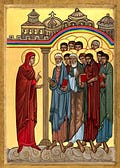



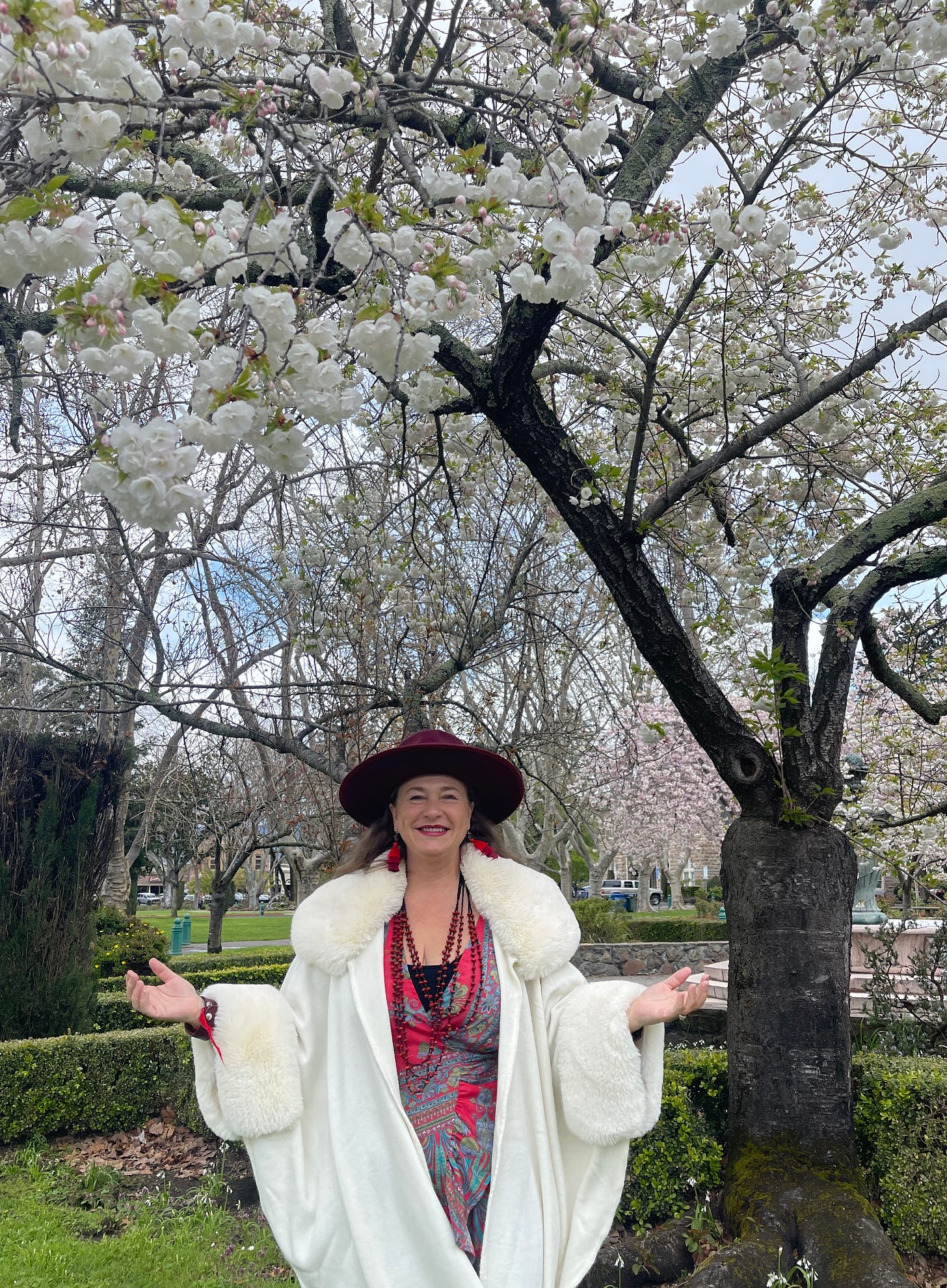



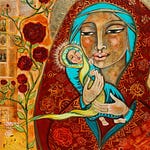
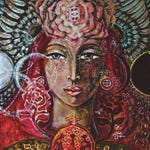
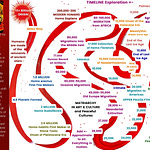
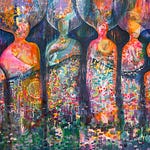
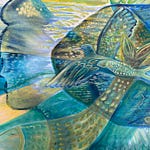
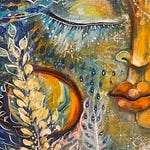
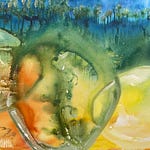
Eostre...Pascha...Easter...What are you present to in this season?